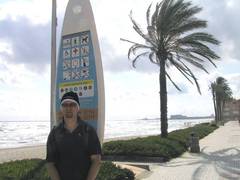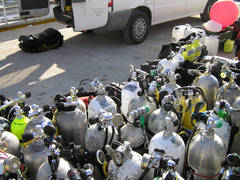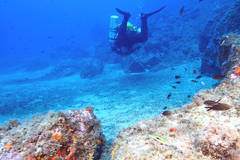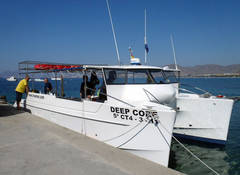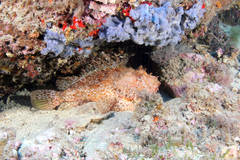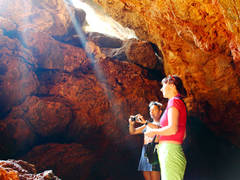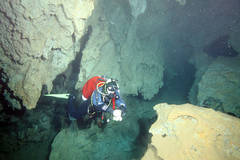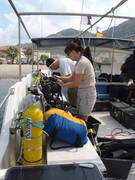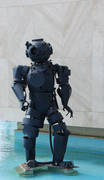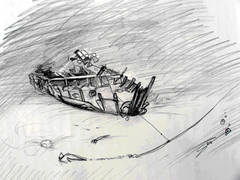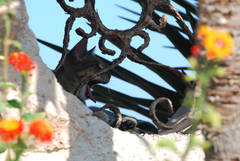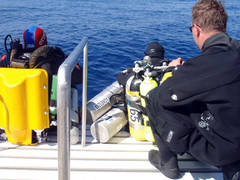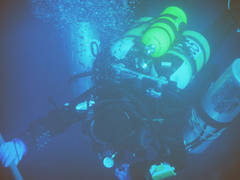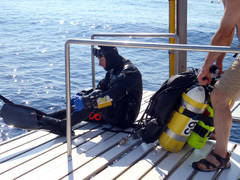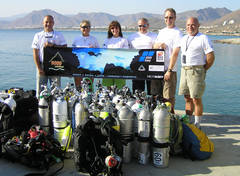Grande finale of the 9000 meters project - behind the Spanish scenes
Paella, mariscos, rough seas, mysterious wrecks, beautiful karst caves, dive to 152m ? these are all my notions of Spain from now on :-)
-23. September 2011: cold-hot
Night ride to Gdansk; 5 in the morning is still very dark and cold! A short sleepy flight with Ryanair to Alicante and finally a big smiling sun welcomed us - just as expected :-)
Our next destination was La Manga - 19-kilometre peninsula, 300m wide max, separating the Mediterranean Sea from a saltwater lagoon Mar Menor. The latter became our own private swimming pool, where we could always count on very warm and very salty water (24 degrees, it would be hardly possible to drawn, because of the amount of melted salt, ideal for swimming though - no waves, shallow and uncrowded - La Manga is already off-season at that time of the year).
24. September: incredibly hot, ale still there is some diving equipment to unload...
Still hot and sunny - Mar Menor very tempting with its ideal swimming conditions; it's also a nice idea to take a walk on the beach from our apartments to 'the downtown'. But still, in the garage, there was an enormous pile of equipment waiting for us to unload - 3 enormous cardboard boxes, 600kg of all the equipment you can imagine arrived from Warsaw...
25. September: underwater search accompanied by water 'snakes'No more excuses - time to dive! Our dive site for that day was SS Lillian, a cargo ship wreck lying at 45 meters near La Manga, sunk during the WW II by U34. But first, we needed to find it! On account of big waves and currents, the anchor landed far away from the wreck, so it was sort of a challenge to find it underwater!
I started search with lustrating the bottom more than a dozen meters around the anchor line, and I happened to find a small white dive reel lost by other divers - at least something! Finally, perhaps not the typical way, I found the anchor line of another boat and I followed it straight to the wreck.
The wreck is in a very good shape, lies on an even keel and houses lots of fish species (giltheads, groupers, breams, barracudas. I was absolutely fascinated by long translucent 'snakes'; later on I learnt they were just chains of fish eggs, freely drifting in the water). The wreck is very well positioned, once you get there - lies on light sandy bottom, sea temperature at 45m around 20 degrees, and visibility 20 meters. The dive was very long, on account of the said search activity, which translated into additional 20 minutes of decompression.
26. September: and we expected it to be less windy than in the Baltic Sea!
The Mediterranean Sea, fabulous water temperatures and visibility, but don't be deceived! It can be still very windy, even though everybody had assured us that the turn of September and October would be a very good dive season - the sea was supposed to remain calm. Anyway, once we had arrived, the wind was so strong that dive boats decided not to leave the port and we could not go diving...
To comfort ourselves a bit, we organised a shrimp feast in the evening - shrimps were incredibly delicious indeed! Still, I must have had too many, because my stomach went on strike on the next day :-(
27. September: mola mola nitrogen narcosis
The next dive was all but what you call typical - the day started with a change of the dive site, and not only site, but the whole surroundings - because of such adverse dive conditions in La Manga, we moved to a tiny place called La Azohia not far from Cartagena, where we could dive in a sheltered bay. It was still a better solution than to stay in La Manga and wait for wind to go down.
The sheltered part of the bay happened to be rather shallow - the maximum depth of that dive was not even 40m, but the dive time was really impressive - over 100 minutes! The whole group was swimming under water along and across the bay, exploring all its nooks and crannies, rocks, stones, bottom, upper layers... It turned out to be an excellent opportunity to watch more sea life: moray eel, scorpion fish, and even mola mola! If not for the fact that it was spotted in very shallow water, we would have thought it was a clear case of a group nitrogen narcosis! But as it was only at several meters depth... mola mola came to visit a shallow water 'beauty parlour' for cleaning and that's why we could watch it - all in all a very unusual encounter, since sunfish is not a common sight!
28. September: no more side tanks to take?!
Another dive day in our shallow bay in La Azohia - let's be honest - all what we could see and explore, we had seen and explored the day before, so the time had come to do some drills. Our dive plan was not overly complex on that day - a dive to 55m of the 'man on the rope' type with a big quantity of side tanks, and it was my task to change their configuration, unclip them, clip them again to another D-ring, clip to a special collective ring, to the anchor line, not forgetting to mind the camera, insensitive to my situation and tenacious in capturing all my mistakes. I would not dwell on that so much, if not for the fact that with all the dive equipment I was carrying I did not quite have the right looks for a movie. But, to be serious, all the drills were completed, which took ages and must have been very boring for the rest of our group, so they decided to undertake another exploration expedition of the bay in the direction of yet another rock...
30. September: a beautiful nymph and thermal springs in Cueva del Agua
The wind still persisted and the sea was rough - according to weather forecast it was to remain that way till next Monday - if not longer! In the meantime we decided to dive in a beautiful thermal cave - Cueva del Agua. We were amazed not only because of its sheer beauty - exquisite forms of rocks, fabulous shades, truly unreal turquoise water colour, but also by a visitant nymph of unearthly beauty, who came to bathe naked to cool down on that hot day. The pulse of the male part of our group became definitely quicker and almost audible at such encounter; hence everybody was ready to dive in no time at all, even though it was so hot... Well, unfortunately for nothing, since the nymph, after her bath, left abruptly in her light steps in an unknown direction...
But still we had the beautiful karst cave to admire; one of its peculiarities is the halocline layer, i.e. the phenomenon of salt and fresh water mixing. Below we also found thermal springs and water temperature rose to the unbelievable 30 degrees. Generally water temperature in the whole cave is around 24 degrees, and the cave is very beautiful, although dangerous and treacherous at the same time - one false careless move with a fin resulted in the immediate lifting of all the sediment around us and the complete loss of visibility - at times we had zero visibility, and rocks were falling down on our heads from above! Now I understand why cave divers regularly use helmets (i.e. not only to hold head lamps). But it was well worth it - the cave is fantastic and still not quite explored - a research project has been going on for some years now and it seems far from complete.
1. October: flying rebreathers and crouching divers
We took a brave attempt to dive to a 105m wreck. It was not a good beginning of the day - Jacek's bottom mix was not useable, not good for a 100m dive at least. We had no luck with the weather, either; still, as long as our dive boat was moving, it was possible to do something, but once it had stopped, a rock'n'roll began! The boat tilted so much to both sides that rebreathers started flying freely around; generally everything which had not been fastened tightly, i.e. stack safely under benches or fastened with ropes from both sides, started moving uncontrollably. It was not any easier for divers - we also had to hold on tight, in order to stay on the boat, and still we had to put all the equipment on! Once I had succeeded and I was thinking how on earth to grab and clip side tanks, because it was simply not possible for anyone to help me with them, suddenly I sat down heavily on the bench, and soon enough, still one level below on the deck. Slowly it started dawning on us that we would not be able to dive that day under such circumstances, so I simply stayed on the deck, in the meantime trying to take off whatever I could from the equipment. Soon I was lying down and flat on a twinset of a support diver and tried to fight seasickness taking control over me, uninvited. I must admit that the support diver fulfilled his role perfectly fine and even put his hood as a pillow to make it more comfortable for me, so in the end I survived. But not everybody was so lucky - one Spanish diver decided to fight seasickness drinking water, but he did not succeed and the water went out sooner then it had gone in. No more attractions that day, we safely arrived to the port. But no diving :-(
2. October: submarines and an old-school diver in Cartagena
According to weather and wind forecasts, it was going to calm down only on Monday, so we took a trip to Cartagena, a pretty city founded in the 3rd century B.C. during the Phoenician conquest. We admired there, among others, submarines (a contemporary one stationed in the port and a historical one, a great-grandmother of contemporary submarines), a statue of a diver wearing old-school equipment comfortably inhabiting a fountain, and a witch guarding a local grocery store. We also saw picturesque remains of Roman and later constructions: coliseum, impressive church, beautiful tenement houses - a very pretty and visitor-friendly city.
3. October: drifting anchor line and twisted deco bar
On that day, in accordance with the weather forecasts, the sea was calm and perfectly flat - ideal sea conditions for a dive to a wreck at 105 meters - Angelo Parrodi, discovered in 2006 by a group of Spanish tech divers, 90 years after it had been sunk by a German submarine during the WW I. We got to the dive site without any problems, for a change, managed to spot the wreck on the echosonar and we could finally dive :-)
The anchor line landed close to the wreck that time, although it was quite loose in the lower part, in fact it was not tight at all, but rather drifting freely in the water for the last 10-15 meters, so it was a long way to the wreck along the line. But the most amazing thing was that at 100m it was still just twilight, instead of pitch black water that we experience in Poland at much shallower depths! The wreck looks good on the sandy bottom, although not much remains of it anymore.
A deco bar was deployed on the last meters, but it was a bit twisted and hence an easy trap to get entangled into. Apart from that, I discovered I needed to take more weight to be on the safe side (before I had reduced my weight practically to zero, but it proved to be hardly sufficient) - all that needed correction before the final dive.
4. October: Cabo de Palos - high noon cats and overpowering siesta
The last day before the final dive was partly devoted to re-checking run times, discussing his or her next day role with everybody, re-checking the number of all the required tanks and regulators, as well as quantities of gases. We also visited Simon, preparing mixes at an incredibly high air temperature, we made the final configuration corrections, so that everything was perfect up to the very last carabiner and we had nothing left but to wait for our mixes and relax.
So, we made a trip to Cabo de Palos, a resort at the very end of our peninsula, and took a seaside path to a lantern. It was incredibly hot; we really envied a group of divers slowly descending to one of turquoise coves for a dive. The sea and the rocks in that area catch the eye with an amazing diversity of colours; in fact, they were so inviting that we almost jumped into the sea with everything on - clothes, shoes, photo cameras.
Since we were there around noon, the resort looked like a ghost town - the duty to celebrate the 'siesta' is obeyed with no exceptions, so even the cats that we met occupied all the available spots of shade.
5. October: a dive to 152m - plan the dive and dive the plan!
We got up early and drove La Azohia. The analyses of mixes were positive - everything's ok :-) We started preparing the equipment and packing everything on the catamaran. Everything was perfectly fine; I even managed to fix an additional small tank to my twinset for the inflation of the wing and suit.
The day was beautiful, everybody in high spirits, everything according to the plan. We got to the dive site by boat, on that day we made the anchor line really tight and deco bar was flawlessly deployed.
It was time to put on all the equipment. Twinset with additional inflation tank, 4 side tanks, all the kinds of backup hoses - would that be all I needed? I sat on the catamaran's 'lift' with Simon, and in no time at all we were in the water and swimming to the anchor line.
The descent was all according to the plan, as well - gas switches and computer switches; we arrived to 100m, then it got dark at last. Simon slowed down at the last meters, so that we do not end up several meters lower than planned - the line went down to 160m+ - very tempting, for a brief moment I was wondering what was down there on the bottom...
But it was time to start the ascent - in the 10th minute we started on our way up. Jacek was waiting for us somewhere around the 100th metre, then at 80th metre there was Ela Benducka, at 65m - Maciek and Tomek Godzina. Maciek took from me travel gases that I did not need any more; I traded them for a tank with oxygen.
Starting from 9th metre decompression stops became really long - we spent over 1 hour at 6 meters! Luckily, from time to time our colleagues visited us, took photos, made movies, Maciek accompanied me till the end of the dive. After some time though, we could occupy ourselves only with watching jellyfish in incredible psychedelic pink colour and read what was written on PCV bars of our deco bar. Our colleagues spotted on the surface a group of graceful dolphins swimming not far from the boat - well, apparently their sense of timing was better than ours on that day.
At last, after 151 minutes, we resurfaced and the lift took us back to the boat. We were welcomed with millions of hugs, congrats, pictures. I was most happy that the whole dive was completed exactly according to the plan and with no surprises - we kept the run time, we had more gases than required in case of an emergency - I was really pleased that the whole dive was accomplished as I had visualised it would be!
Hence, big big thank you to the whole team who contributed to the grand finale: so, primarily, Jacek Lubowiecki and Scuba Training for all the kinds of support: equipment, mental, all the advice and guidelines, years of training and unbreakable faith in my skills and experience!
Also big thanks to all the other team members: Simon, Ela, Maciek, Tomek, Iwonka, Jacek, Radek, other friends and colleagues who supported us in many different ways, and without whom the project would not be successful.
Also, special thanks to Dive Rite and O'Three companies for their equipment support, not only during that particular expedition - we have been successfully using their equipment for years now and it never failed us - neither in the salty Red Sea, nor in the Hancza Lake under ice, nor in the rough Baltic Sea - it works perfectly fine in all dive conditions.
Special thanks also to Diving Poland and Lukan company - for their invaluable support.
To sum up: I am the first woman who completed 9000 meters project. During our expedition to Spain we did not explore all the wrecks we had planned, because of unfavourable weather conditions in the first week - so, we have a good reason to come back to Spain, especially that there is another interesting wreck lying at 160m+ to explore. See you next time then!
You can also explore our photo gallery from Spain.
Photos by: Radek Kochlewski, Ela Benducka, Agnieszka Kiela-Pałys
Agnieszka

